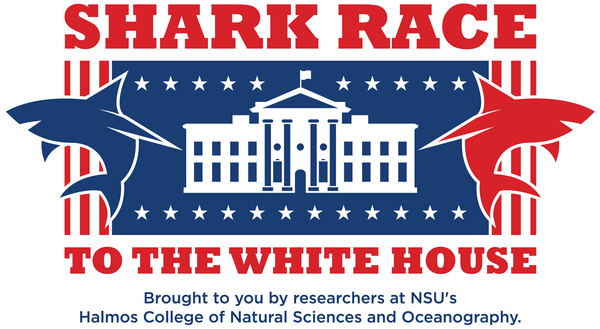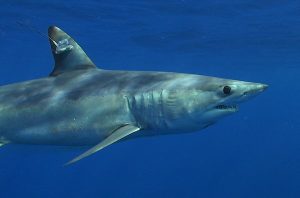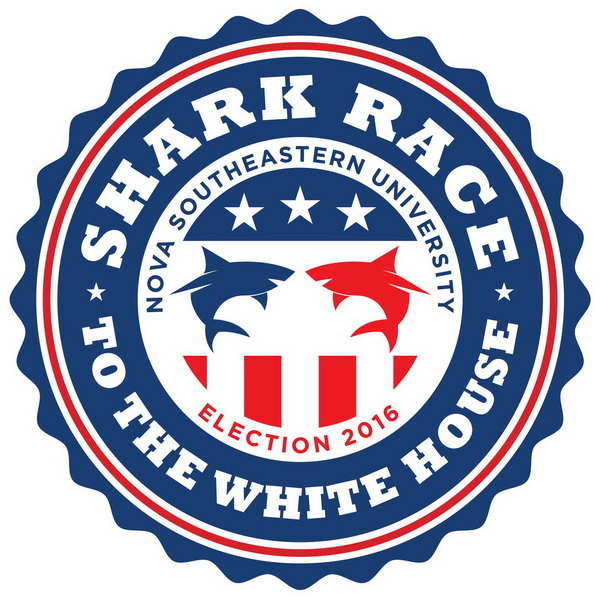
With the Help of Two Tagged Mako Sharks – Follow Them Online nova.edu/presidentialrace
 FORT LAUDERDALE/DAVIE, Fla. – Does the 2016 U.S. Presidential Election have you confused? Tired of hearing the “pundits” pontificate on which candidate is going to win and why? Did the recent debate muddy the waters even more?
FORT LAUDERDALE/DAVIE, Fla. – Does the 2016 U.S. Presidential Election have you confused? Tired of hearing the “pundits” pontificate on which candidate is going to win and why? Did the recent debate muddy the waters even more?
Well, forget the latest poll and look no further – the experts at Nova Southeastern University (NSU) have got you covered! That’s right – and when we say experts, we’re talking about tagged shortfin mako sharks that are part of NSU’s Shark Race to the White House!
These sharks are part of the ongoing marine science research on shark migrations at NSU’s Halmos College of Natural Sciences and Oceanography. The Clinton Shark and the Trump Shark are the latest animal prognosticators to weigh in on an issue of national and international importance. They join the ranks of Punxsutawney Phil, the famous groundhog who lets us know annually how much longer winter will last and Paul the Octopus, the soccer savant who, in 2010, predicted the winner of the World Cup.
What makes this project great is that voters – in fact, anyone in the world – can follow the Clinton Shark and the Trump Shark in near real-time online via NSU’s Shark Race to the White House website (nova.edu/presidentialrace).
This special-edition website allows visitors to “animate” the sharks’ tracks to see where they have traveled, how far they have traveled and more. We also want people to share the race with others via their social media networks using the hashtag #makoprediction
The rules are very simple: On Monday, Sept. 26, as the human candidates took the stage for their first nationally televised debate, NSU researchers starting tracking their marine counterparts – the Clinton Shark (whose motto is “Swimming Stronger Together”) and the Trump Shark (whose motto is “Mako America Great Again”) – as they do what mako sharks do, that is, swim in the Atlantic Ocean.
NSU researchers will continue collecting data from both sharks and then at midnight on November 1st NSU’s Shark Race to the White House will end. At that time, whichever shark has tallied the most miles traveled during the race will be declared the winner and, hence, predict which candidate will win the 2016 U.S. Presidential Election.
The order in which the sharks were named and tagged was based on the scientific laws of mathematical probability – in other words, researchers flipped a coin. The lucky candidate to have their shark tagged first was Hillary Clinton.
These sharks are contributing to the ongoing research by NSU scientists as they learn more about mako sharks in order to better protect them.
“For me, it’s not about politics, it’s about the research,” said NSU President Dr. George Hanbury. “The work being done by NSU’s research scientists is vital. It’s providing incredible opportunities for our students and at the same time, the lessons we’re learning are being used to better protect these animals for future generations.”
While this shark-tracking campaign sounds pretty easy, it’s not. There are a few variables that may come into play.
First, there’s no way to guarantee that both tagged sharks will log a significant number of miles. While they were caught, tagged and released in the same general vicinity, sharks, like humans, tend to follow their own path. There’s the possibility we tagged one shark that likes to venture out into the middle of the Atlantic Ocean, while the other shark prefers to frequent a smaller, more familiar area.
“Some makos we’ve tagged have shown a tremendous propensity to travel thousands of miles, swimming way out in to the Atlantic Ocean into international waters, while others favor a smaller geographic area and stay closer to the continent,” said Mahmood Shivji, Ph.D., an NSU professor who is overseeing this research. “We’ve learned some very interesting things about mako migrations over the past couple of years, but they continue to surprise us. There is clearly a lot more to discover about their behavior.”
Another factor to consider – these sharks aren’t protected or shielded just because they’ve been tagged by NSU researchers. They are swimming in the open ocean, and as such, Shivji said that these sharks, just like every other mako shark, are subject to the perils their natural habitat may bring.
“Since we started tagging and tracking makos, we’ve lost a surprisingly large number of them – nearly 30% – to capture,” Shivji said. “It’s unfortunate as that’s fewer sharks we have providing data, but it shows just what these animals face on a daily basis.”
And there’s also the possibility that a satellite tag will simply stop working, and we’ll lose contact with one or both of the sharks. Hopefully none of these things will happen, and the Clinton Shark and Trump Shark will make it to the end of NSU’s Shark Race to the White House and continue sending researchers vital data for many months and even years to come.
While this is a fun, light-hearted way of looking at the 2016 Presidential Election, the research behind this project is pretty serious.
Dr. Shivji indicated that worldwide, sharks are being killed off in unimaginable numbers – some estimates say between 70-100 million sharks per year. Clearly, that is not a sustainable level of removal, since many shark species, including makos, reproduce at low rates. That’s why the work being done at NSU is vital – we must learn as much as we can about these majestic creatures so we can take steps to ensure they don’t vanish from the Earth. Research has been, and will always be, one of the pillars that supports a world-class education at NSU.
So now you don’t have to worry about polls or debates telling you which candidate is in the lead. All you need to do is turn to the experts at NSU and visit our tracking Website – nova.edu/presidentialrace – to see which candidate is leading the Shark Race to the White House.
And come Nov., 1, may the best shark swim, um, win!
Be sure to sign up for NSU’s RSS feed so you don’t miss any of our news releases, guest editorials and other announcements. Please sign up HERE.
###
About Nova Southeastern University (NSU): Located in beautiful Fort Lauderdale, Florida, Nova Southeastern University (NSU) is a dynamic research institution dedicated to providing high-quality educational programs at the undergraduate, graduate, and first-professional degree levels. A private, not-for-profit institution, NSU has campuses in Fort Lauderdale, Fort Myers, Jacksonville, Miami, Miramar, Orlando, Palm Beach, and Tampa, Florida, as well as San Juan, Puerto Rico, while maintaining a presence online globally. For more than 50 years, NSU has been awarding degrees in a wide range of fields, while fostering groundbreaking research and an impactful commitment to community. Classified as a research university with “high research activity” by the Carnegie Foundation for the Advancement of Teaching, NSU is 1 of only 50 universities nationwide to also be awarded Carnegie’s Community Engagement Classification, and is also the largest private, not-for-profit institution in the United States that meets the U.S. Department of Education’s criteria as a Hispanic-serving Institution. Please visit www.nova.edu for more information about NSU and realizingpotential.nova.edu for more information on the largest fundraising campaign in NSU history.
About NSU’s Halmos College of Natural Sciences and Oceanography: The college provides high-quality undergraduate (bachelor’s degree) and graduate (master’s and doctoral degrees and certificates) education programs in a broad range of disciplines, including marine sciences, mathematics, biophysics, and chemistry. Researchers carry out innovative basic and applied research programs in coral reef biology, ecology, and geology; fish biology, ecology, and conservation; shark and billfish ecology; fisheries science; deep-sea organismal biology and ecology; invertebrate and vertebrate genomics, genetics, molecular ecology, and evolution; microbiology; biodiversity; observation and modeling of large-scale ocean circulation, coastal dynamics, and ocean atmosphere coupling; benthic habitat mapping; biodiversity; histology; and calcification. The college’s newest building is the state-of-the-art Guy Harvey Oceanographic Center, an 86,000-square-foot structure filled with laboratories; offices; seminar rooms; an auditorium; and indoor and outdoor running sea water facilities. Please visit cnso.nova.edu for more information.

